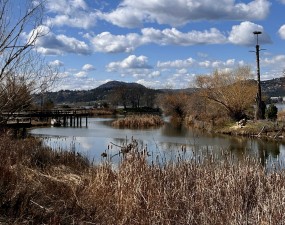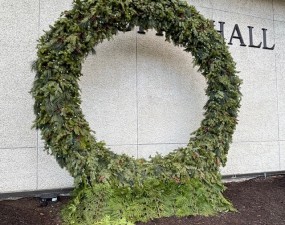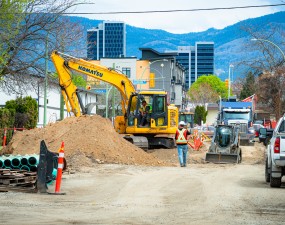Think before you flush: How what you do directly impacts Kelowna’s Wastewater Treatment Facility
Topics
By Kailie Stobbart, Communications Co-Op Student | Sep 20, 2024
Every time you wash your dishes, shower or flush, it’s the start of an unseen underground journey. Your wastewater travels through an intricate system of pipes and pumps before arriving at our Wastewater Treatment Facility (WWTF) that treats, manages, and disinfects whatever goes down the drain.
Understanding what happens with that water once it goes down the drain helps everyone recognize the importance of proper waste disposal, and the impact it has on your home, our community, and the environment. The wrong materials flushed into the system could affect the efficiency of the facility and ultimately Okanagan Lake.
Kelowna’s WWTF manages domestic and industrial wastewater, servicing about 95% of the city’s population, with the remainder on separate septic systems. The WWTF has a treatment capacity of 70 million litres per day - or enough to fill 28 Olympic-sized swimming pools!
“A proper running facility is what keeps our city running. That’s why it is more important than ever to be mindful of what you are flushing into the system,” says Mike Gosselin, Wastewater Manager.
After you flush
When your wastewater enters the facility, it goes through the primary level of treatment. This involves screens (6mm incline screens) and settling tanks (primary clarifiers) to eliminate most solids from the wastewater. This step is crucial, as nearly 52% of heavier solids are removed by screen, with 99.5% of suspended solids removed by the entire process. The screens are typically small enough to capture sticks, garbage, and other large debris. These materials are then removed, cleaned and taken to the landfill.
Next, the water enters Primary Clarifiers, where the flow is slowed significantly. During this time, sludge settles at the bottom, and a layer of scum forms on the surface. The scum is skimmed off, the sludge is extracted from the bottom and sent to the fermenters, and the partially treated wastewater proceeds to the secondary treatment stage.
The partially treated wastewater flows into the bioreactor, where bacteria treat the liquid through a process called Biological Nutrient Removal (BNR). This technology, commonly used for municipal wastewater and non-toxic industrial waste, effectively removes up to 95% of Biological Oxygen Demand (BOD), about 95% of suspended solids, and up to 99.99% of fecal coliforms. The BNR process mainly targets ammonia and phosphorus, helping to prevent algae blooms in the lake caused by excess nutrients and low oxygen levels.
In the tertiary treatment process, the remaining wastewater passes through a series of disk filters to filter out any remaining small particulate/solids before being sent to UV treatment. Here, the UV treatment inactivates any bacteria and remaining pathogens before the water is sent to the lake.
Although this treatment greatly reduces harmful substances, it doesn't remove all pollutants. Chemicals poured down the drain can survive all treatment stages, potentially killing the beneficial bacteria that clean the sludge. These chemicals may also bypass UV treatment and end up back in the lake, adds Gosselin.
A biological innovation
Instead of dumping all the waste sludge from the facility into the landfill, it is mixed with a polymer, then dewatered in a centrifuge to form a solid cake. The cake is then taken to a composting site, where it's mixed with wood waste to create OgoGrow—a compost that enriches soil by adding organic matter and essential nutrients. OgoGrow can be purchased at the Glenmore Landfill and at most retail nursery outlets in Kelowna and select nurseries in Vernon. OgoGrow is available in wholesale amounts at the Regional Compost Facility.
Weird encounters
“Everything that gets flushed or goes down the sink will inevitably end up at the treatment facility. We’ve had our fair share of interesting items end up in our screening process,” Gosselin explains.
Some interesting items that ended up at the WWTF include:
- Jewelry
- Shoes
- Money
- RV sewer hoses
While these items might seem unique and interesting, it's crucial to prevent them from entering the sewage system. Even though the WWTF has a screening process, treatment doesn't fully remove chemicals from the water, which can harm the entire system. The fact that these items made it to the WWTF means they didn't clog pipes, but they could have caused costly issues for multiple neighborhoods. Everyone must work together to keep these items out of the sewage facility.
To flush or not to flush
“Even if products say they are flushable, they shouldn’t be flushed,” says Gosselin. Some drugs and pharmaceuticals can’t be treated or removed at the WWTF and should never be flushed down the drain or toilet, as they’ll end up in Okanagan Lake.
The Sanitary Sewer Storm Drain Regulation Bylaw details what can and cannot be dumped down the drain. Hazardous waste should never be disposed of down the drain or the sewer as it can damage the entire system and ultimately get dumped into the lake. You can find further information on recycling and disposal options for a variety of hazardous wastes at Regional District of Central Okanagan and Recycling Council of BC.
The BC Medications Return Program provides detailed information on where to properly dispose of unused pharmaceuticals and medications.
What the FOG?
Cooking oil and grease are the major causes of sewer blockages in Kelowna— more than $60,000 is spent annually to clear these blockages in the City’s sewers. Paper towels, tampon applicators, Q-Tip’s, and even dental floss can cause a messy clog in pipes, causing blockages across the system.
Fats, oils, and grease (FOG) can easily go down the drain when hot. However, as FOG cools, it solidifies and sticks to pipes, causing blockages that lead to costly sewer backups and possible storm water contamination.
FOG can also clog your household plumbing, leading to expensive plumber visits. To avoid these issues, never flush FOG down the drain. Instead, drain it into a reusable container, refrigerate it, and then throw it in the trash. Alternatively, pour FOG into a disposable container, seal it, let it cool, and then toss it in the garbage.
Think before you flush. Let’s all do our part to maintain the WWTF and ensure the water going back into Okanagan Lake is as clean as possible. To learn more about the WWTF and the wastewater treatment process, visit Wastewater | City of Kelowna.
More than just pipe dreams: Unclogging fun facts
- There are more than 650 km of sewer piping under Kelowna – enough to go all the way to Calgary!
- The WWTF treats an average of 13,505 billion litres of wastewater per year!
Links:
Activated Sludge - an overview | ScienceDirect Topics
report_-_2023_annual_kelowna_wwtf_website_version.pdf
Glenmore Landfill | City of Kelowna
Regional Compost Facility | City of Kelowna
Regional District of Central Okanagan (rdco.com)







